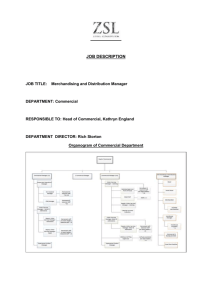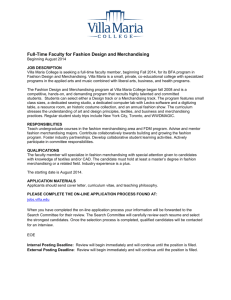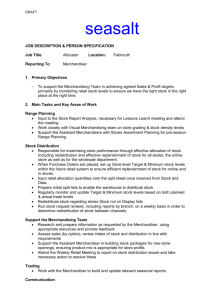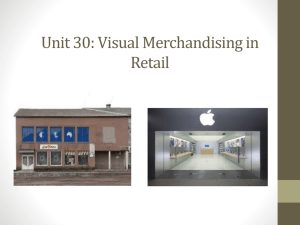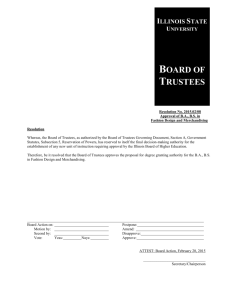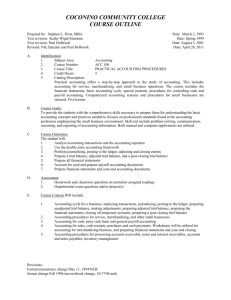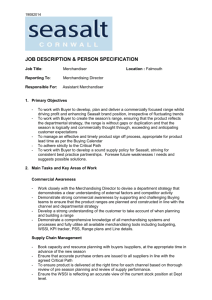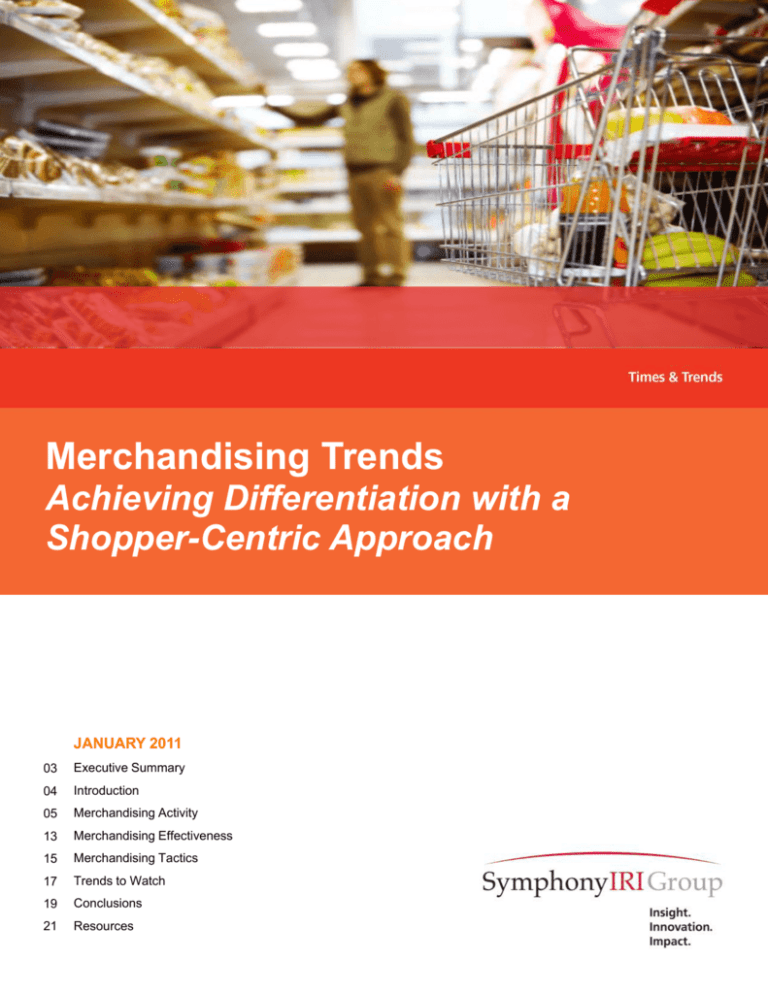
Merchandising Trends
Achieving Differentiation with a
Shopper-Centric Approach
JANUARY 2011
03
Executive Summary
04
Introduction
05
Merchandising Activity
13
Merchandising Effectiveness
15
Merchandising Tactics
17
Trends to Watch
19
Conclusions
21
Resources
1
Merchandising Trends: Achieving Differentiation with a Shopper-Centric Approach
Creative Merchandising Critical to CPG and Retail Success in 2011
The new year creates an opportunity to review product and retail strategies with a view toward continuous
improvement. Nowhere is this more relevant or important than in merchandising strategies.
While experts are still writing their post mortems on the 2010 holiday season, it is clear that consumer spending
exhibited a strength not seen since 2006. What remains to be determined, however, is whether the holidays
represented a one time splurge from shoppers with “frugal fatigue” or a genuine uptick in attitudes and
behaviors that will carry over into the new year. It is also unclear whether gift purchasing activity will translate
into increased sales of traditional consumer packaged goods, such as grocery, health or beauty aid items.
SymphonyIRI anticipates shoppers will remain conservative in their purchasing habits, but evolve their
definition of “value” slowly away from the almost singular focus on price that has shaped behavior for the past
three years. The new focus will be one that integrates other factors, such as ingredients to support increased
health & wellness, packaging and convenience.
The challenges for those leading merchandising efforts are multifold. They must determine which shopper
segments are motivated by which types of merchandising activities, typically a combination of price, feature
and display activities. Within each segment, they must gauge which products generate the greatest sales
volume lift from each type of support. They must evaluate which merchandising strategies achieve the greatest
benefit within their category and/or channel. And, they must understand the interplay between merchandising
strategies for national brands and private label brands.
Critical to the future success of CPG and retail companies alike will be weaning shoppers off price-related
merchandising. In 2009, price-only merchandising activity increased across 79 percent of CPG categories, a
figure that has moderated to the still-too-high 53 percent in 2010. Going forward, managers must rely on
innovative merchandising strategies focused on a mix of feature, display and price to gain the optimum balance
between attracting shoppers to the product and earning the margins necessary to sustain and grow the brand.
An important component of addressing merchandising, pricing and other CPG and retail challenges will be to
attend SymphonyIRI Group’s 2011 Summit Conference, with the theme of “Gaining the Competitive Edge.”
Among the keynote speakers in place are Gary Hamel, author of “Leading the Revolution” and “Competing for
the Future,” Mark Zandi, chief economist, Moody’s Analytics; and Salman Amin, executive vice president,
Global Sales and Marketing, PepsiCo. The conference will take place at the Fontainebleau Miami Beach,
March 28-30, 2011. Early bird registration is now available and offers attendees $300 off the regular price, an
excellent example of well-crafted merchandising!
We look forward to seeing you there!
Robert I. Tomei
President, Consumer & Shopper Insights
© Copyright 2011 SymphonyIRI Group, Inc. All rights reserved.
2
Merchandising Trends: Achieving Differentiation with a Shopper-Centric Approach
Executive Summary: Turning Insights Into Action
Insight
After accelerating sharply in 2009, merchandising
Action
Consistently balance promotional efforts with
activity growth slowed in the past year; still,
everyday value-oriented programs that are
merchandising support is escalating across a
consistently aligned with partner goals/objectives
majority of CPG categories and tactics
as well as the needs of key target consumers
In stark contrast to pre-recession trends, grocers
Leverage technological advances that allow for
have stepped up display activity during the past
micro-level shopper marketing and enable
year
marketers to reach key consumer segments with
a “less is more” approach
The ranks of the categories seeing the biggest
Carefully evaluate price elasticity of demand
jump in merchandising activity are well-
across key categories and brands, and leverage
represented by products related to home-based
this knowledge to create highly targeted
eating rituals; price-only actions are becoming
everyday and promotional strategies that reflect
more prevalent across many of these categories
consumers’ evolving definition of value and
affordability
Volume lift from merchandising support has
Maximize impact of merchandising efforts with
declined across more than half of CPG categories;
strategies tightly targeted against key shopper
this decline is fairly consistent across CPG
and high-priority segments at the market and
channels
store level
Private label receives lower-than-average
Retailers should enhance the relevance and
merchandising support across a majority of CPG,
positioning of merchandising programs across
and support declined across nearly half of private
key private label categories and brands with
label categories during the past year
solutions-based programs and/or co-branded and
multi-tier programs targeted against key shopper
segments
© Copyright 2011 SymphonyIRI Group, Inc. All rights reserved.
3
Merchandising Trends: Achieving Differentiation with a Shopper-Centric Approach
Introduction
Early in the recession, as CPG prices
CPG marketers are playing a very
With conservative purchase behaviors
escalated and consumers adopted
important role in consumers’ lives today.
expected to persist and inflation predicted
increasingly aggressive strategies for
From eating and drinking to health and
to escalate in 2011, the time for CPG
finding the best value for their CPG dollar,
home care, packaged goods products
marketers to understand what is driving
CPG retailers and manufacturers honed
allow consumers to save money and time
and inhibiting lift among key consumer and
their value image with stepped-up
on a wide range of daily essentials.
target groups is now.
Today’s consumers are looking for all of
This issue of Times & Trends explores
It was a fairly marked shift from previous
these things and more. More means
current and emerging merchandising
years, when clean-floor policies, all part of
value.
trends that CPG marketers have embraced
promotional and merchandising activity.
during the past few years in an effort to
the quest to create an enhanced shopping
experience for consumers, were
To provide value, marketers are relying on
satisfy consumers’ rapidly changing
eradicating display space and intensifying
merchandising. In the past year,
definition of value.
merchandising competition.
merchandising support has increased
across a majority of CPG categories, and
In the coming years, these strategies must
Today, that enhanced shopping experience
increases cut across CPG channels. But,
become highly segmented tools that are
is very much a different phenomenon.
average lift achieved from these efforts has
measured and monitored from a variety of
Providing an enhanced shopping
slipped across more than 50% of
viewpoints to enable real-time adjustments
experience is all about delivering against
categories, and overall CPG unit sales
that are reflective of the changing needs
consumers’ complex and evolving
increased less than 1% for the year.
and wants of key consumer and target
definition of value. As difficult as this task
segments.
is, achieving this goal translates to
substantial growth opportunity for CPG
marketers.
© Copyright 2011 SymphonyIRI Group, Inc. All rights reserved.
4
Merchandising Trends: Achieving Differentiation with a Shopper-Centric Approach
Merchandising Activity: Total CPG
Increasing
Declining
2007
2008
50% 54%57%
51%
2009
2010
39%
38%
33%
30%
53%
79%
13%
12%
11%10%
47%
21%
0% 0% 0% 0%
0-29.9%
30-49.9%
50-69.9%
70%+
% of CPG Categories
by Merchandising Activity Level, 2007-2010
38%
46%
78%
54%
22%
56% 59% 59%
68%
44% 41% 41%
32%
2008 2009 2010 2008 2009 2010 2008 2009 2010
FDMx
% Volume, Any Merchandising
Source: SymphonyIRI InfoScan Reviews™; 52 weeks ending 10/31/2010 and
same period prior year, and calendar year 2007-2008
62%
Grocery
Drug
Source: SymphonyIRI InfoScan Reviews™; 52 weeks ending 10/31/2010 versus
same period prior year and calendar year 2008-2009 versus prior year
% of CPG Categories
with Increasing/Declining Merchandising Activity
Across grocery, drug and mass
channels accelerated sharply. During this
channel. Still, 56% of CPG categories are
merchandise channels, about 43% of CPG
difficult economic time, nearly 80% of CPG
seeing merchandising support climb within
volume is sold with merchandising support
categories experienced stepped up
the grocery channel.
(defined as displays, feature ads, feature
merchandising support.
On average, 70% of CPG categories sell
and display combined and price reduction
Increases were evidenced across CPG
more than 30% of their volume with
channels, but were particularly strong in
merchandising support. This is a sharp
In today’s marketplace, which is heavily
grocery. At that time, grocers were fighting
increase, nearly 10 points, over a four year
marked by caution and frugality, it is no
to stem multi-year share losses and to
time period. The shift serves to
surprise that merchandising activity has
fortify their image vis-à-vis value versus
underscore the intensity that exists within
increased during the past several years.
competing channels, particularly
the CPG market today--the intensity with
During this time, merchandising has, in
supercenters.
which consumers are courting value, and
only).
the intensity with which CPG marketers are
fact, been a critical component of CPG
marketer efforts to attract and retain
During the past year, as the escalation of
competing for valuable share of wallet and
market share and stimulate purchase
merchandising support moderated, grocery
associated market share.
behavior.
channel shifts were more significant versus
industry average and versus the drug
In 2009, merchandising support across
grocery, drug and mass merchandise
© Copyright 2011 SymphonyIRI Group, Inc. All rights reserved.
5
Merchandising Trends: Achieving Differentiation with a Shopper-Centric Approach
Merchandising Activity: Grocery Channel
2.4%
0.7% 0.9%
1.6%
1.3%
0.5%
-0.4%
0.7% 0.4%
0.1%
2.7%
1.2%
-0.7% -0.7%
-0.8%
-1.2%
1.5% 1.2%
2.2%
-1.9%
Quad Quad Quad Quad Quad Quad Quad Quad Quad Quad Quad Quad Quad Quad Quad Quad Quad Quad Quad Quad
Wk 5 Wk 6 Wk 7 Wk 8 Wk 9 Wk 10 Wk 11 Wk 12 Wk 1 Wk 2 Wk 3 Wk 4 Wk 5 Wk 6 Wk 7 Wk 8 Wk 9 Wk 10 Wk 11 Wk 12
2009
2010
Source: SymphonyIRI In-Store Solutions Group Perimeter View YTD Through 11/28/2010
Average Number of Grocery Channel Displays per Store per Week
% Change versus Prior Year by Quad Week
Point
Change vs
Prior Year
Salty Snacks
Crackers
12.2 (0.1)
9.2
Grocery display trends have been erratic
Note: SymphonyIRI In-Store Solutions Group
but generally positive during much of 2010,
Perimeter View measures UPCs displayed in
and, for the most part, growth has been
stronger versus year ago trends.
This growth underscores ongoing efforts by
8.9
+0.2
Carb. Beverages
8.1
Wine
• Lobby
• Front End Cap
• Back End Cap
+0.1
Cookies
the following eight areas:
• All Other End Cap
• Perimeter
grocers to enhance their value image and
• In Aisle
(0.1)
protect and grow share across key grocery
• Seasonal/Promotional Aisle
7.7
+0.1
categories. Illustrated in SymphonyIRI’s
Non-Choc.
Candy
7.3
0.0
Choc. Candy
6.4
+0.1
Bread & Rolls
6.1
0.0
Snack
Nuts/Seeds
5.9
+0.1
SS Bot. Juices
5.5
(0.1)
• Shipper
August 2010 issue of Times & Trends,
In the foreseeable future, consumers will
grocers were able to stem multi-year share
hold tight to their conservative attitudes
losses in 2009, and continued to protect
and behaviors and cross channel
that share in 2010, though the channel did
competition will remain intense.
not build additional share during that time.
Still, consumers’ appetite for a simple and
Source: SymphonyIRI In-Store Solutions Group
Perimeter View YTD Through 11/28/2010
Rather, cross channel competition for
“clean” shopping experience is strong.
share of consumer spending has heated
Discussed later in this report, technology
up and efforts to elevate the value profile
has made smart and effective
Average Number of Displays
are building momentum across CPG
Per Store per Week: Grocery Channel
channels.
merchandising strategies not only possible,
but easier than ever.
© Copyright 2011 SymphonyIRI Group, Inc. All rights reserved.
6
Merchandising Trends: Achieving Differentiation with a Shopper-Centric Approach
Merchandising Activity: Total CPG
2009
2010
79%
70%
69%
56%
49%
points, and shelf-stable seafood and
pasta each rose 1.8 points during the same
78%
64%
frozen/refrigerated poultry climbed 1.9
62%
period.
53%
52%
Each of the other merchandising tactics
analyzed in this report experienced a sharp
de-escalation in merchandising support
growth trends in 2009. Still, on average,
Feature &
Display
Display
Feature
Price Only
Any
Merchandising
growth is occurring across a majority of
CPG categories.
Undoubtedly, continued focus on
Source: SymphonyIRI InfoScan Reviews™; 52 weeks ending 10/31/2010 and same period prior year
% of Categories with Increased Merchandising Activity
By Merchandising Tactic
Food, Drug & Mass Channels (Excluding Walmart)
Despite a deceleration in merchandising
feature-only support. For instance, 37% of
activity, nearly two-thirds of CPG
vitamin volume is sold in this manner, as is
categories saw increased merchandising
about one-third of hair coloring and eye
support in the past year. To be detailed
and facial cosmetics.
marketers’ quest to answer consumers’
unwavering search for value and
affordability. Though the recession has
officially ended, consumers are holding
firm to their conservative ways. Discussed
in SymphonyIRI’s August 2010 issue of
Times & Trends, nearly half of consumers
chose their most recent grocery retailer
later in this report, categories related to
home-based food rituals are well-
A number of categories related to home-
represented among the ranks of the most
based eating rituals also achieve a sizable
heavily merchandised categories.
share of volume with feature-only support.
About one-quarter of ice cream/sherbet
After escalating more slowly in 2009
and refrigerated salad/coleslaw volume, for
versus other merchandising tactics
instance, are attributed to feature-only
analyzed in this report, growth in feature-
actions.
because that retailer offered low prices on
desired items.
With many consumers still struggling to
make ends meet and inflation expected to
increase in 2011, the drive for value and
affordability will remain strong in the
coming year. This trend will leave CPG
only support led the way in 2010, climbing
among two-thirds of CPG categories.
merchandising support is the result of CPG
Feature-only support is clearly on the rise
in each of these CPG departments.
Health and beauty care products are
Vitamins volume sold with feature-only
prevalent among the ranks of products
support increased by 3.4 points in 2010.
receiving the most volume with
Blades increased by 3.0 points,
marketers in the throws of a struggle to
protect and grow share without
undermining margin and profitability goals.
© Copyright 2011 SymphonyIRI Group, Inc. All rights reserved.
7
Merchandising Trends: Achieving Differentiation with a Shopper-Centric Approach
Merchandising Activity: Most Active Categories
The ranks of the most heavily
Point Change
vs Prior Year
merchandised CPG categories are wellrepresented by discretionary categories.
Carbonated Beverages
At the top of the list is carbonated
beverages. The carbonated soft drinks
0.7
74%
Chocolate Candy
64%
(0.7)
Salty Snacks
63%
2.2
Sports Drinks
62%
1.6
Batteries
61%
3.1
Bottled Water
60%
(0.1)
Crackers
60%
0.9
market, long a highly competitive sector of
the CPG industry, achieves about threequarters of its volume with merchandising
support. A majority of this support, 27%,
takes the form of combined feature and
display activity, though price-only actions
grew faster than other tactics during the
past year.
The batteries category experienced a
Ice Cream/Sherbet
57%
(0.6)
Frozen Pizza
57%
2.6
Mexican Foods
57%
0.9
sizable jump in merchandising support
during 2010, achieving nearly two-thirds of
volume with support during the past year.
Merchandising was stepped up across
each of the tactics analyzed in this report,
Source: SymphonyIRI InfoScan Reviews™; 52 weeks ending 10/31/2010; Among top 100 categories
Top 10 Categories by Merchandising Activity Level
Food, Drug & Mass Channels (Excluding Walmart)
% Volume, Any Merchandising
with the greatest increase coming in priceonly actions. These actions, combined
pizza. This shift in consumer behavior,
Snack marketers are leveraging
with a strong and growing presence of
and retailer efforts to elevate their image of
merchandising as a means of attracting
private label, contributed to an average
low-cost providers of key CPG solutions
those consumers who may otherwise not
price per volume slide of more than 7% for
makes use of feature-based merchandising
visit the snack aisle due to efforts to
the category during this time period.
activity to support the category quite
eliminate non-essential spending. As seen
logical. During the past year, volume lift
in the frozen pizza category, retailers are
The frozen pizza category also
from feature only and feature with display
leveraging this tactic to highlight the value
experienced a significant jump in
support has been commendable, at 164%
and affordability that they offer in the
merchandising support during the past
and 385%, respectively.
category. Also as seen in the frozen pizza
category, volume lift from feature with
year. The increase was due to stepped up
use of frozen pizza as a feature, both alone
The salty snacks category also
display support in salty snacks has been
and with display support.
experienced a sizable jump in
substantial, at 274%.
merchandising support during the past
The frozen pizza category has
year, mostly from stepped-up focus on
demonstrated strong growth during the
feature with display support.
past few years, as consumers have been
seeking lower-cost alternatives to dine-out
© Copyright 2011 SymphonyIRI Group, Inc. All rights reserved.
8
Merchandising Trends: Achieving Differentiation with a Shopper-Centric Approach
Merchandising Activity: Category Trends
Shelf Stable Seafood
Dog Food
Butter
4.5
Vitamins
Eye Cosmetics
Milk -13.9
5.4
4.1
3.6
-9.2
Fz Breakfast Food
-4.6
Breakfast Meats
-4.5
-3.3
Rfg Bread Dough/Biscuits
3.3
Natural Cheese
Vegetables
3.2
Rfg Fresh Eggs
-2.8
Cat Food
3.2
Sugar
-2.8
Batteries
3.1
Processed Cheese
-2.6
Pasta
3.1
Ref Salad/Coleslaw
-2.3
Tomato Products
3.0
Rtd Tea/Coffee
-2.1
Source: SymphonyIRI InfoScan Reviews™; 52 weeks ending 10/31/2010 versus same period prior year
CPG Categories with the Largest Increases/Decreases in Merchandising Activity Level
Food, Drug & Mass Channels (Excluding Walmart)
% Volume, Any Merchandising: Point Change vs Prior Year
A majority of CPG categories experienced
little increase in feature with display
Those categories that saw merchandising
stepped-up merchandising support during
support. Meanwhile, volume sold with
support decline, in general, saw only small
the past year. Across a range of CPG
price-only and feature-only tactics
slides. On average across grocery, drug
categories these increases were rather
increased 1.8 and 1.7 points, respectively.
and mass merchandise channels,
substantial. Many of those categories
This shift is certainly logical, as it is quite
merchandising activity slipped only slightly
experiencing the highest jump in
difficult to efficiently display categories
during this time period, down 0.4 points
merchandising support are key
requiring refrigeration or freezer-based
versus the same period in 2009. Certainly,
battlegrounds in the quest for share of
merchandising.
some exceptions experienced larger cuts.
The vitamins category also experienced
Nearly all of the categories experiencing an
For instance, several meal ingredient and
slight declines in volume sold with
easing of merchandising support saw cuts
meal component categories have been
display-only support. Discussed earlier in
in price-only actions. Five of these
more heavily merchandised in recent
this report, vitamins experienced a sizable
categories are dairy categories which had
months. Increases are occurring across
jump in volume sold with combined feature
been slashing prices earlier in the
tactics with few exceptions.
and display merchandising support as
recession in attempt to drive demand. This
retailers look to attract shoppers to their
price-cutting trend may have ended during
The refrigerated bread dough/biscuits
stores with powerful money-saving offers
the past year.
category, for instance, experienced a small
on this strong-performing healthcare
decline in display-only actions, and very
category.
consumer spending.
© Copyright 2011 SymphonyIRI Group, Inc. All rights reserved.
9
Merchandising Trends: Achieving Differentiation with a Shopper-Centric Approach
Merchandising Activity: Category Trends- Health & Beauty
Healthcare
Beauty/Personal Care
62%
Vitamins
Cold/Allergy/Sinus Tablets
34%
27%
Soap
Internal Analgesics
32%
22%
Toothpaste
Gastrointestinal Tablets
26%
21%
First Aid Accessories
57%
Diapers
47%
29%
50%
40%
46%
50%
40%
Sanitary Napkins/Tampons
24%
22%
31%
36%
Skin Care
23%
Drug
Food
Source: SymphonyIRI InfoScan Reviews™; 52 weeks ending 10/31/2010. Top five categories in each department, ranked by dollar sales, FDMx
% Volume, Any Merchandising
Among Leading Health & Beauty Care Categories
Drug vs Grocery Channel
Drug channel share of healthcare and
Across a majority of the top five categories
The five largest healthcare categories
beauty care products is sizable, at 60%
in each of these departments,
receive average to above-average
and 42%, respectively. For years, though,
merchandising support is above average
merchandising support in the grocery
these departments have been at the heart
and on the rise. Internal analgesics is a
channel. Vitamins and first aid accessories
of a share battle between drug and grocery
notable exception; support in this category
each saw merchandising support grow in
channel retailers. In this environment of
slid across each of the tactics detailed in
the past year despite an average decline in
frugality and self-reliance, where
this report.
the department.
satisfying their health and beauty care
Merchandising support for health and
Within the beauty department, toothpaste
needs in the home rather than in a
beauty care products within the grocery
and soap are merchandised much more
professional’s office, the battle for share of
channel is also fairly strong. In the
heavily versus the department as a whole.
these categories remains fierce.
channel, 22% of healthcare volume and
And, while skin care merchandising
29% of beauty care volume is sold with
support is currently slightly below average,
As a result, merchandising support across
merchandising support. Within the
this past year saw percent of skin care
health and beauty care products is fairly
channel, on average, though,
volume sold with merchandising support
high. In drug stores, an average 31% of
merchandising trends have been largely
increase almost two points, driven by
healthcare volume and 39% of beauty care
flat in the past year.
increases in feature-only, display-only and
consumers are playing an increased role in
volume is sold with merchandising support.
price-only actions.
© Copyright 2011 SymphonyIRI Group, Inc. All rights reserved.
10
Merchandising Trends: Achieving Differentiation with a Shopper-Centric Approach
Merchandising Activity: Category Trends- Meal Ingredients and Components
60%
Price Only
Any Merchandising
65%
60%
44%
41%
30%
Center Store
Frozen Foods
Fresh/Perishable
Source: SymphonyIRI InfoScan Reviews™; 52 weeks ending 10/31/2010
% of Categories with Increased Merchandising Activity
Among Fresh/Perishable, Frozen Foods and Center Store
Categories Grocery Channel
With consumers fully-entrenched in home-
An increase in the prevalence of feature-
Detailed in SymphonyIRI’s November 2010
based eating rituals and conservative
only tactics is visible in key frozen and
issue of Times & Trends, the allure of
purchase behaviors, CPG marketers are
fresh/perishable departments. Discussed
price-related merchandising actions is
well-aware of the importance of protecting
earlier in this report, this logical trend
quite strong in today’s competitive CPG
and growing share across food and
results from retailer efforts to build and
environment. And, as upward pressure on
beverage categories. As a result,
fortify their image as a low-cost provider of
commodity and list prices intensifies,
merchandising in support of these
everyday food and beverage solutions.
driving retail prices northward, this
categories is on the rise.
Key meal ingredient and meal component
temptation will increase.
categories, including refrigerated bread
In the center of the store, merchandising
dough/biscuits, frozen seafood and frozen
CPG marketers beware: the industry must
increased across 65% of categories in the
pizza are illustrative of this trend.
break out of the vicious cycle of excessive
promotional activity. Pricing strategies
past year. Food and beverage categories,
including shelf-stable seafood, pasta and
Price-only actions also continue to gain
must be rewired. Those marketers who
canned/bottled vegetables, are prevalent
steam across key food and beverage
carefully develop and monitor their pricing
among those center store categories
departments, In frozen foods and
strategies to ensure a solid balance
seeing the largest boost in volume sold
fresh/perishable, for instance, price-only
between offering value and protecting
with merchandising support, at +5.3 points,
actions increased across 44% and 30% of
margin will be best positioned for growth in
+3.1 points and +3.0 points, respectively.
categories, respectively.
the coming months and years.
Increases occurred across tactics.
© Copyright 2011 SymphonyIRI Group, Inc. All rights reserved.
11
Merchandising Trends: Achieving Differentiation with a Shopper-Centric Approach
Merchandising Activity: Category Trends- Private Label
2009
2010
68% 69%
57% 58%
61% 60%
Display
Feature
Feature &
Display
53%
57%
Price Only
61% 61%
Any
*Note: Based on % volume, any merchandising for total category versus private label
Source: SymphonyIRI InfoScan Reviews™; 52 weeks ending 10/31/2010 and same period prior year
% of Categories w/ Private Label Merchandising Activity Below Average*
By Merchandising Tactic
Food, Drug & Mass Channels (Excluding Walmart)
46%
It is a time of significant opportunity for
categories. And, in 46% of categories,
retailers offering private label CPG
merchandising activity has declined during
solutions. Detailed in extensive private
the past year.
label research published by SymphonyIRI
38%
throughout 2010, these products have
Many shoppers have become more open
played an important role in helping
to trying and buying private label products
consumers to save money in difficult
during the course of the economic
economic conditions while simultaneously
downturn. CPG marketers must work to
bolstering performance for private label
address this opportunity.
marketers by alleviating downward
Private Label
Total Category
pressure on margin.
For private label marketers, merchandising
these products aggressively and accurately
Source: SymphonyIRI InfoScan Reviews™; 52 weeks
ending 10/31/2010.
% CPG Categories
with Reduced Merchandising
Activity
It is a time when retailers and private label
will help to raise the bar on private label to
manufacturers should be prominently
the next level. For national brand
showcasing their products across
marketers, increased prevalence and
promotional platforms. Quite the contrary
precision of merchandising efforts
holds true, though. In general, private
increases the likelihood that they will
label receives lower-than-average support
protect and grow share of their key
across nearly two-thirds of CPG
products and brands.
© Copyright 2011 SymphonyIRI Group, Inc. All rights reserved.
12
Merchandising Trends: Achieving Differentiation with a Shopper-Centric Approach
Merchandising Effectiveness: Total CPG
34% 35%
2009
2009
2010
2010
41% 40%
56%
57%
52%
55%
58%
56%
20% 20%
4%
0-49.9%
50-99.9%
100-149.9%
5%
150+%
Source: SymphonyIRI InfoScan Reviews™; 52 weeks ending 10/31/2010 and
same period prior year
% of CPG Categories
by Average Merchandising Lift, 2009 & 2010
FDMx
Grocery
Drug
Source: SymphonyIRI InfoScan Reviews™; 52 weeks ending 10/31/2010 and
same period prior year
% of CPG Categories
with Reduced Merchandising Lift, 2009 & 2010
Despite consumers’ intent focus on saving
markedly within grocery versus competing
to buy. In fact, these strategies oft times
money and related “sale shopping” fervor,
channels, and the change was not in a
appeal to only a very finite segment of the
average merchandising lift changed very
positive direction.
market.
categories receiving merchandising
At the total CPG level and across grocery,
Still, this time of change, when some
support experienced average lift of 88% in
drug and mass merchandise channels,
consumers are sticking with frugal
2010, only a slight increase versus the
average depth of discount has remained
shopping behaviors and others are
85% lift achieved the prior year.
largely unchanged during the past year.
reverting to more free-spending ways, is a
Still, the degree to which merchandising
time of opportunity for CPG marketers.
little during the past year. In 2010,
Certainly, some categories are known to
activity is motivating consumers to buy has
achieve much higher lift than others, often
decreased slightly during this timeframe.
Detailed in SymphonyIRI’s recent Point of
View, titled “Blunt Force Trauma: When
due to the nature of the product, ease of
storage, and/or frequency of use. Some of
CPG marketers must work to understand
Average Execution is Just That,” now is the
these categories will be explored later in
this trend. What is working well? What is
time to invest in aggressive, carefully
this report.
not working well? What categories/brands
planned shopper-centric segmentation
are performing well? What
strategies. As consumers continue to re-
categories/brands are under-performing?
evaluate their attitudes and associated
The largest shift in average merchandising
shopping behaviors, the deployment of
lift occurred in the grocery channel. Within
grocery, average lift from merchandising
In any given channel, market or category,
such strategies has the potential to build
support slipped in 55% of CPG categories.
the answers are likely to be unique, simply
shopper loyalty and create long-term
While this is on par with performance
because market dynamics are so varied.
revenue and share lift.
within other CPG channels, the trend
One-size-fits-all strategies are no longer an
versus 2009 performance changed more
effective means of motivating consumers
© Copyright 2011 SymphonyIRI Group, Inc. All rights reserved.
13
Merchandising Trends: Achieving Differentiation with a Shopper-Centric Approach
Merchandising Effectiveness: Leading Categories
% Volume w/ Any
Merch.
% Volume Increase w/ Any Merch. Support
Paper Towels
220%
Toilet Tissue
210%
Shelf Stable Seafood
190%
Breakfast Meats
182%
Frankfurters
174%
Change in % Inc in
Volume w/ Merch
53.2%
+9.2
52.0%
+6.6
44.7%
+23.4
52.2%
(11.6)
53.3%
+4.0
Cold Cereal
164%
50.3%
+0.5
Baking Mixes
160%
49.2%
(6.0)
Shortening & Oil
156%
47.9%
+20.3
Coffee
152%
49.7%
+4.1
Chocolate Candy
152%
64.1%
(14.6)
Source: SymphonyIRI InfoScan Reviews™; 52 weeks ending 10/31/2010 versus same period prior year
Top 10 CPG Categories by Merchandising Lift
Food, Drug & Mass (Excluding Walmart)
2010
Mentioned earlier in this report, select
merchandising support are categories tied
are reducing and/or eliminating
categories tend to achieve particularly
closely to consumers’ home-based eating
discretionary purchases. Price-related
strong lift with merchandising support. Not
rituals. But, even in some of these key
actions, on the other hand, have served to
surprisingly, these categories tend to
categories, merchandising lift has fallen
level the playing field and make indulgence
capture a large percentage of their annual
during the past year, a critical issue which
just a bit more “justifiable.”
volume sales with merchandising support.
was addressed earlier in this report.
Shortening & oil, on the other hand, has
Last year’s ranks of categories achieving
For instance, lift within the chocolate candy
seen a substantial boost in the impact of
the highest volume lift from merchandising
category fell nearly 15 points in 2010. In
merchandising support. In 2010, this
support illustrates the fact that lift tends to
the category, lift fell across all measured
category sold just under half of its volume
be heavily influenced by nature of the
tactics, except price-only. This category
with merchandising support and achieved
product, storability and/or frequency of
has experienced price increases during the
lift of more than 150% from merchandising
product use.
past few years, which certainly has not
efforts. While lift increased across tactics,
helped to stimulate increased demand
feature with display support and price-only
during a time when consumers
actions brought the strongest results.
In 2010, many of those categories
achieving the highest lift from
© Copyright 2011 SymphonyIRI Group, Inc. All rights reserved.
14
Merchandising Trends: Achieving Differentiation with a Shopper-Centric Approach
Merchandising Tactics: Prevalence & Effectiveness
% of Categories with at Least 10% of
Volume with Tactic
Price Only
% of Categories Achieving at
Least 100% Lift with Tactic
Price Only
85%
Feature
39%
Feature
Display
35%
Display
Feature & Display
Feature & Display
7%
1%
47%
28%
85%
Source: SymphonyIRI InfoScan Reviews™; 52 weeks ending 10/31/2010
Merchandising Activity & Lift by Tactic
Food, Drug & Mass Channels (Excluding Walmart)
2010
In 2010, 85% of CPG categories saw lift of
shopping during the past several years.
in-tune with the effects of pricing strategy
more than 100% with display actions
They are planning ahead, and circulars are
on consumer attitude and behavior.
backed by feature support, and 47% of
helping them to make more informed
categories achieved these results with
decisions about what to buy and where to
CPG marketers must take the time to
feature-only support. Still, use of these
buy it.
understand the price elasticity of demand
tactics remains fairly low. Only 7% and
across key categories/brands and use that
39% of categories, respectively, achieved
In contrast, 85% of CPG categories
knowledge not only in the development of
greater than 10% of volume sales with the
achieved at least 10% of their volume with
promotional strategies, but also when
support of feature-based merchandising.
price-only merchandising support despite
creating their everyday pricing strategies.
the fact that lift from such actions is
And, they must do so at a very micro-level.
Feature support, with or without display
relatively low. Just 1% of categories saw
A consumer-centric approach to pricing,
actions, has clearly demonstrated a more
lift of more than 100% from price-only
whether everyday or promotional, is much
favorable consumer response versus other
efforts in the past year.
more likely versus broadly-targeted tactics
merchandising tactics during the past year.
to deliver an effective value proposition
Addressed frequently in SymphonyIRI
With price sensitivity quite high and poised
that will entice shoppers to buy and still
reports, consumers have adopted a much
to remain that way for the foreseeable
deliver against corporate and partner
more deliberate approach to grocery
future, CPG marketers must be very
goals.
© Copyright 2011 SymphonyIRI Group, Inc. All rights reserved.
15
Merchandising Trends: Achieving Differentiation with a Shopper-Centric Approach
Merchandising Tactics: Top Categories- Effectiveness
Feature & Display
SS Seafood
1,204%
Display Only
Feature Only
Price Only
SS Seafood
341%
SS Seafood
235%
Breakfast Meats
105%
102%
Paper Towels
680%
Shortening & Oil
268%
Toilet Tissue
206%
Frankfurters
Toilet Tissue
678%
Baking Mixes
257%
Chocolate Candy
182%
Chocolate Candy
95%
Shortening & Oil
675%
Paper Towels
242%
Can./Bot. Fruit
181%
Fz/Rfg Poultry
94%
Cold Cereal
674%
Breakfast Meats
238%
Cold Cereal
174%
Fz Seafood
83%
Source: SymphonyIRI InfoScan Reviews™; 52 weeks ending 10/31/2010; Among top 100 CPG categories
Categories Achieving the Highest Lift
by Merchandising Tactic
Despite difficult economic conditions and
Stock-up categories, such as paper towels
In the coming months, consumers are
associated conservative consumer
and toilet tissues, also respond well to
expected to remain fully entrenched in
attitudes and behaviors, response to
merchandising support. In fact, across
conservative behaviors. Self-reliant and
promotional support remains strong. Many
three of the tactics studied for this report,
home-based rituals, from health and
consumers, in fact, are stocking up on key
lift in each of these categories is greater
beauty care to eating in and pet care, will
CPG needs during promotional periods in
than 150%. Lift is lower, yet still quite
remain prevalent. As such, categories
order to save money over time.
respectable, when price-only actions are
catering to these trends will continue to
taken. When temporary price cuts are
play a key role in CPG marketers’ growth
Discussed earlier in this report, the ranks
made with no additional support, paper
strategies. Those marketers who deliver
of those categories responding most
towels and toilet tissue see volume
their strategies with a micro-level focus and
favorably to merchandising support are
increase 72% and 74%, respectively.
the utmost precision will be well-positioned
illustrative of consumers’ at-home and
to protect and grow share across key
from-home food rituals.
consumer and target markets.
© Copyright 2011 SymphonyIRI Group, Inc. All rights reserved.
16
Merchandising Trends: Achieving Differentiation with a Shopper-Centric Approach
Trends to Watch
Several trends will continue to heavily
influence the future of in-store marketing,
Printed Coupons from the Internet
but two trends will play a formative role in
On-Pack Promotions: On-Line & Text
the future of this field.
58%
47%
Paperless Coupon Sent to Loyalty Card
36%
iPhone Apps
35%
Printable Shopping List from Website
33%
Shopper Marketing
SymphonyIRI’s May 2010 issue of Times &
Kiosks
30%
shopper marketing. A complex topic,
Mobile Coupons
30%
shopper marketing is centered on the
Scannable QR Codes
Trends is wholly dedicated to the topic of
notion that tomorrow’s most effective
Touch-Screen Digital Signs
marketing programs will begin with a 360°
GPS-Based Location Services
view of the shopper. And, that shopper
perspective will be at the individual level,
21%
18%
14%
Source: In-Store Marketing Institute, Shopper Marketing Trends Report 2011
rather than aggregate level.
Prevalent “Digital Shopper-Marketing” Tactics
as % Responding Companies Employing the Tactic
To make this happen, the CPG industry
must shift its quest for marketing prowess
Technology
into high gear. The information necessary
recent study by the In-Store Marketing
Institute reveals that 58% of companies
to understand shoppers at this intimate
Technology will be a major influencer of
are using the Internet to provide printable
level already exists. Going forward, the
shopper marketing in the coming months
coupons, while about one-third are
challenge is to harness that information,
and years. It will impact the shopper in the
embracing paperless coupons that can be
cultivate it into knowledge, and use that
home, in the store, and everywhere in
sent to loyalty cards and/or mobile
knowledge to develop and execute
between.
coupons.
Technology is also informing CPG
Certainly, coupons are just the tip of the
marketers. From mobile apps to social
iceberg. Technology already runs broad
networks, CPG marketers are learning
and deep in the world of CPG marketing.
more about what consumers want and
Going forward, technology will advance,
what will influence shoppers to buy.
adoption will grow, and the world of CPG
programs that drive not only purchase
behavior, but also true shopper loyalty.
"Shopper marketing has been around
for a long time with other names.
What's changing are the technology
platforms that allow people to
communicate with each other and
marketers to communicate with their
marketing will continue to evolve.
Adoption is occurring rapidly and across a
wide range of technology platforms. A
consumers and shoppers.”
Robert Tomei
President, Consumer & Shopper Marketing
SymphonyIRI Group
© Copyright 2011 SymphonyIRI Group, Inc. All rights reserved.
17
Merchandising Trends: Achieving Differentiation with a Shopper-Centric Approach
Conclusions: CPG Manufacturers
Manufacturers seeking to maximize opportunity within the new, emerging retail environment should
consider the following action items:
Identify new growth opportunities and threats
- Understand price elasticity of demand across key categories/brands and leverage
that knowledge to develop and refine everyday and promotional pricing strategies
- Evaluate merchandising activity and lift across your brands versus total category
and competitors across key retail partners to identify gaps
- Carefully monitor changing consumer dynamics to identify opportunities to build
trial and/or repeat purchase through cross-merchandising of relevant parallel
categories/brands
- Collaborate with key retailer partners to identify and test new marketing
vehicles/tactics within the store environment, and across traditional and new
media
Work with key accounts to develop strategies that address market and store level
shopping patterns and needs
- Continually re-evaluate pricing and merchandising initiatives to ensure alignment
with partner goals/objectives as well as needs of key target consumers
- Focus on highly targeted, solutions-based merchandising programs that deliver
against the needs and wants of key shopper segments at the market and/or store
level
Continually measure and monitor pricing and merchandising executions and impact
- Monitor store-level merchandising performance and retail execution among key
retail partners and adjust mid-path, as warranted
- Carefully test all pricing and merchandising initiatives at a micro level prior to roll
out and then closely monitor impact of roll out
© Copyright 2011 SymphonyIRI Group, Inc. All rights reserved.
18
Merchandising Trends: Achieving Differentiation with a Shopper-Centric Approach
Conclusions: CPG Retailers
Retailers seeking to maximize opportunity within the new, emerging retail environment should
consider the following action items:
Identify new growth opportunities and threats
- Understand price elasticity of demand across key categories and leverage that
knowledge to develop and refine everyday and promotional pricing strategies
- Continually evaluate response to merchandising initiatives vis-à-vis store sales,
share of sales and consumer satisfaction, particularly across high-response
categories
- Carefully monitor changing consumer dynamics to identify opportunities to build
share and loyalty by cross-merchandising of relevant parallel categories/products
- Test new in-store marketing vehicles/tactics and assess consumer response
versus traditional techniques
Work with key manufacturer partners to develop strategies that address market and
store level shopping patterns and needs
- Build cross-merchandising/cross-promotional programs that make parallel
products easier to locate/access
- Focus on highly targeted, solutions-based merchandising programs that deliver
against the needs and wants of key shopper segments at the market and/or store
level
Continually measure and monitor pricing and merchandising executions and impact
- Monitor merchandising programs at the store level for planned versus actual
performance and adjust mid-path, as warranted
- Carefully test all pricing and merchandising initiatives at a micro level prior to roll
out and then closely monitor impact of roll out
© Copyright 2011 SymphonyIRI Group, Inc. All rights reserved.
19
Merchandising Trends: Achieving Differentiation with a Shopper-Centric Approach
Resources
To gain insight into opportunities that exist to leverage unique and actionable content about
consumers and shoppers, and analytical solutions and platforms that drive more effective
and efficient shopper marketing, contact your SymphonyIRI client service representative
regarding custom analyses leveraging the following resources:
SymphonyIRI Shopper Marketing
SymphonyIRI’s Shopper Marketing Suite is a holistic
Suite™
solution that combines advanced, proprietary, and proven
modeling techniques with practical business application
that allows you to define and implement your shopper
strategies.
SymphonyIRI Loyalty
SymphonyIRI’s Loyalty Advantage™ is the best solution for
Advantage™
shopper marketing programs with comprehensive decisionspecific insights based on basket and customer-level detail
and incorporating the industry-leading segmentations of
SymphonyIRI’s Shopper Marketing Suite™.
SymphonyIRI Shopper Insights
Shopper Insights Advantage™ Powered by SymphonyIRI
Advantage™
Liquid Data™ is SymphonyIRI’s transformational tool for
creating actionable consumer and shopper insights.
SymphonyIRI ShopperSights™
ShopperSights™ provides marketers the most powerful
and innovative shopper segmentation and targeting
solution for unprecedented optimization of promotion,
media, distribution, and retail-specific marketing and sales
programs.
SymphonyIRI Digital Media
Digital Media Solutions is a Consumer & Shopper Insights
Solutions
solution, providing manufacturers and retailers the ability to
target digital media more effectively and efficiently, and
quantify the effects of online advertising.
© Copyright 2011 SymphonyIRI Group, Inc. All rights reserved.
20
Merchandising Trends: Achieving Differentiation with a Shopper-Centric Approach
FOR MORE INFORMATION
Please contact Susan Viamari at
Susan.Viamari@SymphonyIRI.com
with questions or comments about this
report.
About SymphonyIRI Group
SymphonyIRI Group, formerly named
Information Resources, Inc. (“IRI”), is
the global leader in innovative solutions
and services for driving revenue and
profit growth in CPG, retail and
healthcare companies. SymphonyIRI
offers two families of solutions: Core IRI
solutions for market measurement and
Symphony Advantage solutions for
enabling new growth opportunities in
marketing, sales, shopper marketing
and category management.
SymphonyIRI solutions uniquely
combine content, analytics and
technology to deliver maximum impact.
SymphonyIRI helps companies create,
plan and execute forward-looking,
shopper-centric strategies across every
level of the organization. For more
information, visit
www.SymphonyIRI.com.
Corporate Headquarters:
150 North Clinton Street
Chicago, IL 60661
Telephone: +1 312 726 1221
www.SymphonyIRI.com
© Copyright 2011 SymphonyIRI Group, Inc. All rights reserved.
21

